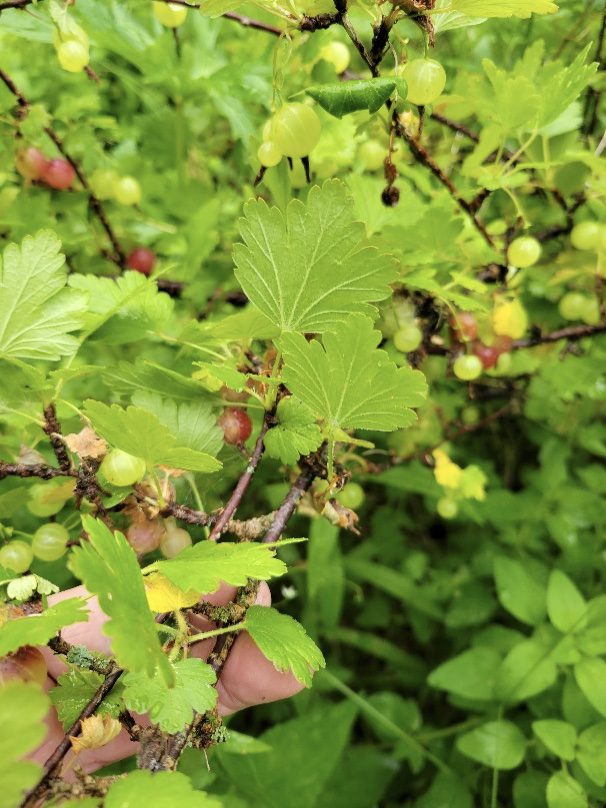Your cart is currently empty!
Gooseberry Jelly
Bee, Berries, bird, Blossom, Cucumber, Dieback, Fertilizer, Fruit, Glove, Gooseberry, Gooseberry jelly, Health, Juice, Mosquito, Organic fertilizer, Pectin, Recipe, rosa mundi, Rose, Roses, spent blooms, Tea, Teaspoon, tomato, Vegetables, Vines, Winter
I decided to make gooseberry jelly instead of jam as it takes less preparation time. The gooseberry gin that I made last year was delicious as well.
Greetings fellow gardeners,
It is officially summer, but we had some very cool weather in the past few days. Last Saturday I was working at a show and just about froze to pieces! When weather like this happens, keep an eye on your plants. The single digit numbers mean protecting tender annuals.
Despite the weather, which is now warming up, I am seeing the first stirrings of life from my cucumber vine. I had some difficulty getting my cucumbers to germinate this year so I may try some different cultivars next spring. Now I need to watch for cucumber beetles. This vine is in a different spot, so I hope they don’t find it. Watch for small, striped beetles and you can see them on the flowers first. If I see one, I squish it right away; but remember if you see one, there will be more.
Fertilizing Regime for Tomatoes
This week I am starting my fertilizing regime. Once a week I will fertilize my tomatoes and other vegetables with my fish emulsion fertilizer. This fertilizer comes in a concentrate, and I add about 2 teaspoons to a watering can. I have found this to be the best fertilizer to prevent blossom end rot in tomatoes. Remember, tomatoes need regular water, no splash-back of water on leaves, and regular fertilizer. If you are using a box fertilizer for tomato food, please read the directions carefully as too much can burn your plants. If you use too much fish emulsion, you will smell like the sea! Feeding a light organic fertilizer weekly to your vegetables and potted annuals will help maintain your garden.
Removing Spent Blooms
The other maintenance chore to do at this time is deadheading. Removing spent blooms from your annuals keeps them blooming for longer. Removing rose blooms once they have finished helps to prolong your bloom time and gives you an opportunity to check the health of your roses. Last winter was hard on the roses and they had a lot of dieback. I removed all the dead branches, and they all came back beautifully.

Picking Gooseberries
I am very happy with my gooseberries this year and am preparing to harvest them. Gooseberries are not the easiest to pick, and you may want to wear gloves. I am picking the green gooseberries along with the softer red gooseberries for a delicious mix. Also, it takes some time to clean the fruit and remove all those little stems, so I need to find a minute to sit down for that. I decided to make gooseberry jelly instead of jam as it takes less preparation time. The gooseberry gin that I made last year was delicious as well.

After dodging prickles, mosquitoes and weeds I was able to pick 2 cups of gooseberries.
Gooseberry Jelly Recipe
Place gooseberries in a heavy pot and cover the berries with water. Bring to a boil on medium heat until the fruit is pulpy and soft, then simmer on low for about 10 minutes. Pour the berries into a sieve lined with cheesecloth that is over a container. Leave the container and sieve in the refrigerator overnight.
You will have your juice once it has been strained. Each cup of juice gets a cup of sugar. Bring this mixture to a boil and boil to the jelly stage. I use a canning thermometer to ensure that I have reached this stage. Gooseberries are high in pectin, so I don’t add any more pectin to the mix. Once the jelly stage has been reached, bottle it in sterilized jars and place them back in the sterilizing pot for a 10-minute hot water bath.
With the rain that we had here last night I am expecting to be greeted by lots of mosquitoes as I do my chores this morning. I am happy to see all the birds lining up to eat them! Judith (Email: sghorticultural@gmail.com) Veggie Bites are available at https://sghorticultural.wixsite.com/website or https://gardeningcalendar.ca/articles/veggie-bites/
Share with Family and Friends
Featured Authors
Visit a Botanical Garden For Unique Experiences.
Comments
Logging in to comment gives you more features, but it is not required.
Subscribe
0 Comments
Oldest












